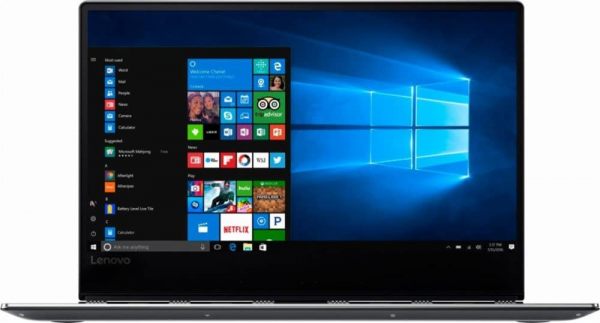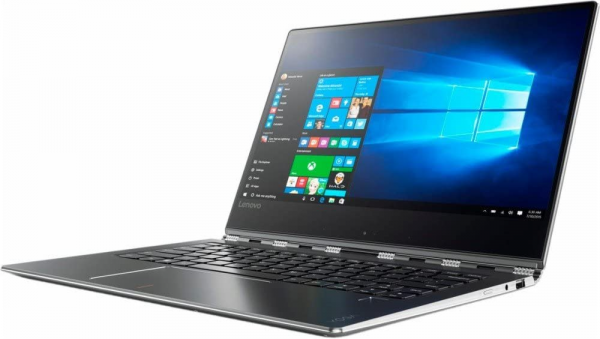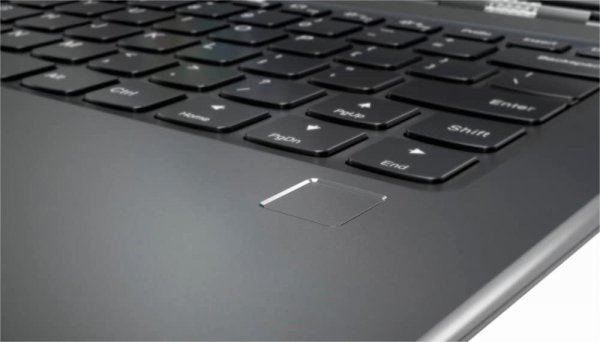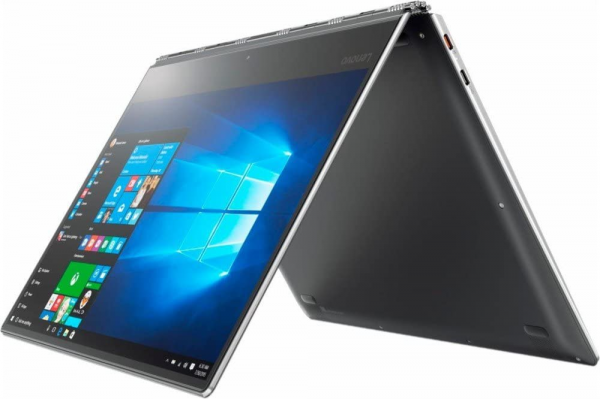Lenovo
Lenovo Yoga 910: the flawless convertible
Aprox. 958€ - see price -
See specificationsLenovo's high-end hybrid ultrabook is reinventing itself with the Yoga 910. A laptop that has been improved enough to overshadow its predecessor and approach perfection.
Our review
Construction
The Chinese Lenovo is right to hang on to the chassis that we are starting to know well and which was notably at work on the Yoga 900 with the highlight of a 360 ° metal hinge inspired by watchmaking. It is therefore a pleasure to find it on this Yoga 910 which evolves quite slightly, but in a good way.
Its dimensions and weight are almost identical (323 x 224.5 x 14.3 mm, and 1.4 kg). We are therefore faced with a real ultrabook, the main difference from its predecessor is no longer a 13.3 ”screen, but a 13.9” screen. How is it possible? Quite simply by drastically reducing the size of the screen borders and taking advantage of this gain not to reduce the size of the chassis, but to enlarge the display surface. An intelligent solution that allows Lenovo to stand out from the crowd by offering one of the most compact 14 "ultrabooks. Smart.
By handling the Yoga 910 you immediately perceive the great care taken in the finishes and which highlights successful lines and design. All aluminum, it gives up the soft-touch coating of the Yoga 900 without making any big difference, except on the fingerprints which are less visible and tenacious on this new model. We even have, personally, a preference for the new finishes which avoid the two-tone side and which seem to us both more sober and more classy, for a perfect alliance with the particular style of the hinge.
A hinge which, we repeat, opens on 360 ° and allows to use the Yoga 910 as a classic laptop PC but also as a tablet by completely folding the screen on the back of the computer, or even to pass in tent mode to enjoy a less bulky screen when you are content to watch a video. Tested and approved on the train or plane. As we could have realized during our Yoga 900 test, if this hinge does not please everyone from an aesthetic point of view, it has the merit of being perfectly thought out, solid, and not to let appear no play.
Laptop first and foremost, the Yoga 910 had to take care of its input devices. The fully clickable touchpad is very pleasant, while the backlit chiclet keyboard is comfortable and precise enough to type a lot of text.
The connection part is ultimately the only one that gets poorer by modernizing. Indeed, while the Yoga 900 offered three USB-A ports including two with the USB 3.0 standard, a USB-C port and an SD card reader in addition to the Jack combo, here we must be content with one and only USB 3.0 Type A port, supplemented by two USB-C ports, one of which is used for charging. If the combo Jack is obviously maintained, the SD Card slot is deleted. To try to be forgiven, the Yoga 910 incorporates a biometric fingerprint sensor that can be configured through the Windows Hello function to unlock a session without having to enter a password. It's practical and it works well.
On the cooling side, not surprisingly, the Yoga 910 remains an excellent student. In everyday use, we have never heard it blow, while it has always remained particularly cool. It must indeed be subjected to heavy tasks and occupy 100% of its CPU for a while to hear it blow slightly (37 dB measured on the sound level meter). This remains negligible and we can consider this machine to be very quiet. After a long charging period, the hottest point detected is strangely located at the hinge at the front (44.8 ° C).

Screen
While we had tested the 13.3 ”screen of the Yoga 900 in its QHD version, this time we are in the presence of a version of the Yoga 910 equipped with a 13.9” glossy touch screen at the Full HD definition, ie 1920 x 1080 px . Good news, the behavior of this screen is much better, with a contrast which stands at 1063: 1 - which is good for IPS -, with a maximum brightness of 355 cd / m² which limits part of the inconvenience of a shiny tile outdoors or with a light source in the back.
The colorimetry measured with the probe gives rise to an average delta E at 4.5 which indicates a slight chromatic drift which nevertheless remains barely perceptible, while the color temperature is established at 6378 K, very close to the desired standard of 6500 K Small flat on the gamma curve, which seriously lacks stability at the end of the race, which betrays somewhat burnt whites.

Performances
Inside the Yoga 910, what changes is obviously the switch to a seventh generation Intel Core processor, exploiting the Kaby Lake architecture. The configuration tested is thus composed of a Core i7-7500U processor, 8 GB of RAM and a 256 GB SSD. The Kaby Lake chip benefits like the whole range from an increase in its operating frequencies compared to the i7-6500U under Skylake architecture. A gain authorized by an optimized burning process and dubbed 14nm + by Intel. It is a dual-core with 4 MB of cache eligible for HyperThreading which runs at 2.7 GHz, with a Turbo mode at 3.5 GHz.
Unsurprisingly, the Yoga 910 is a model of responsiveness and it can handle all kinds of tasks without coughing. The performance index obtained following numerous tests carried out in fields as varied as video encoding, 3D rendering, compression or photo processing confirms our good impressions. To not spoil anything, the on-board SSD gives a nice boost to the whole by allowing quick starts and waking from sleep.

Games
We don't do wonders in game without a dedicated graphics processor. The i7-7500U of Yoga 910 does not even have the right to the IGP Intel HD Graphics 630 new generation, having to settle for HD 620. It is therefore little to say that we did not expect much- thing for the practice of video games . Video game lovers will have to know how to be satisfied with 3D engines that show a certain age and small games that are not very ambitious graphically.
The Christmas holidays are approaching and you find yourself trapped in the family country house for a whole week. Between two naps, ...
Mobility / Autonomy
Thin and light, the Yoga 910 is an ultra-mobile portable, thought to accompany us on the move. Its 3-in-1 approach confirms this even more in this nomadic use. As a result, it is fashionable to know that it comes with a USB-C sector charger of small dimensions, which takes only little space in a bag and does not weigh it down.
In terms of autonomy, this version of the Yoga 910 with Full HD screen turns out to be much better than the Yoga 900 that we tested with QHD screen. If the latter had to be satisfied with an autonomy of 4:58 in our video playback test under Netflix (brightness set to 200 cd / m², Wi-Fi activated and headphones connected), here we made a huge leap forward (9:23 ). Excellent autonomy that we also have seen in the daily use that we have been able to make of Yoga 910, which generally lasted more than 9 hours before requiring a recharge.
Audio
No surprise regarding the sound part of this Yoga 910. Its headphone output is quality, with a good dynamic range, almost no distortion and a powerful output volume.
As for the speakers - in partnership with JBL - it's more complicated. If laptops rarely deliver correct sound, it's even harder for ultrabooks in general, which have to do with a very thin chassis. For technical reasons, we could not submit these speakers to our usual test protocol, but by ear, the sound of the Yoga 910 is not very detailed, quickly saturates, but offers a correct power. In short, it helps to watch a video, but it will not look much further.
Conclusion
Connectivity aside, the Yoga 910 enhances the already very successful recipe for a Yoga 900 which had already made a strong impression on us. And since its autonomy is much better and its screen is enlarged without enlarging the chassis, while offering a rendering of a whole new level, we do not see well how to not assign it the fifth star that was missing from its predecessor. A very good ultrabook that plays the hybrid card in an intelligent way, while ensuring performance.
Specifications
Reviews


Top of the line laptop for the price
I love this laptop. It's lightweight, powerful, fast, has a long battery life, and it works very well in general. It reboots in about 5 seconds, and you can completely bend it backwards and it will switch to tablet mode that has been designed for touch screen use. The only problem I have encountered is my computer crashing / going black when using Shockwave on Chrome. You can hear the fans sometimes, but they don't bother me as they aren't too loud. I bought this laptop refurbished for a great deal: about 20% off of the website's new asking price. It came without a box or manual, just the laptop and charger. It looked and acted new when I took it out. It had no bumps or blemishes. Its shipping packaging allowed for it to arrive safely. I bought a laptop for the same price previously, and it was heavy, slow, and had a short battery life and very loud fans, so this is a great laptop for the price.
touch screen stopped working immediately after warranty expiration
You know, I really liked this laptop for the first year I got. It has great battery life, it's very light weight and durable. Good internal mic and speakers.
I have a few gripes though with this machine. One, my touch screen stopped functioning almost immediately after the warranty expired. There are no fixes other than taking it in to a professional. Without the touch screen, it's just an expensive laptop and its functionality is cut in half.
Lenovo support is a travesty. Takes forever, their updates reduce functionality, and many of their updates autmatically override settings. I wouldn't really be surprised if one of the updates was responsible for the screen malfunctioning.
The computer is solid, but I won't be buying another lenovo for the aforementioned reasons.
Not super fast and the display is only ok compared to ...
Not super fast and the display is only ok compared to my MacBook. The trackpad is kind of awful and the flip screen hinge has gotten loose over only a month or so leaving it to sometimes flop around dangerously
Not full one year warranty!
Purchased brand new and now it says that warranty is to expired. Warranty start date is set on Jul 2017 so I have 87 days warranty left on a brand new product that is supposed to have a one year support. Starting to have issues w / laptop not charging, etc. Should have purchased a Surface.
Excellent value, specs, and quality
Great laptop - excellent battery life and nice keyboard. Right shift key not a big issue and camera placement correctable via tent mode. Fan noise issue appears corrected because fan noise is non-existent. Bought used-like new from prosale and excellent value for quality laptop.
Lenova never disappoints
This is one in a series of Lenovo laptops I have owned. They are reliable, consistent and easy to use